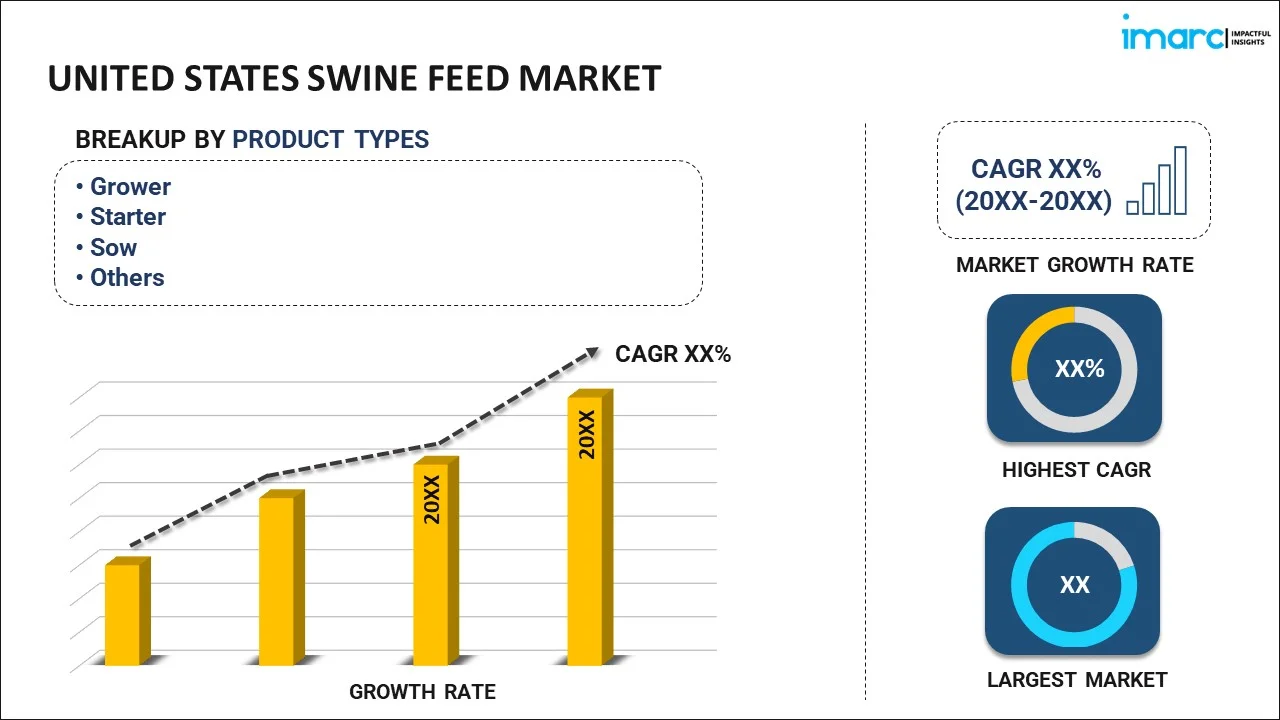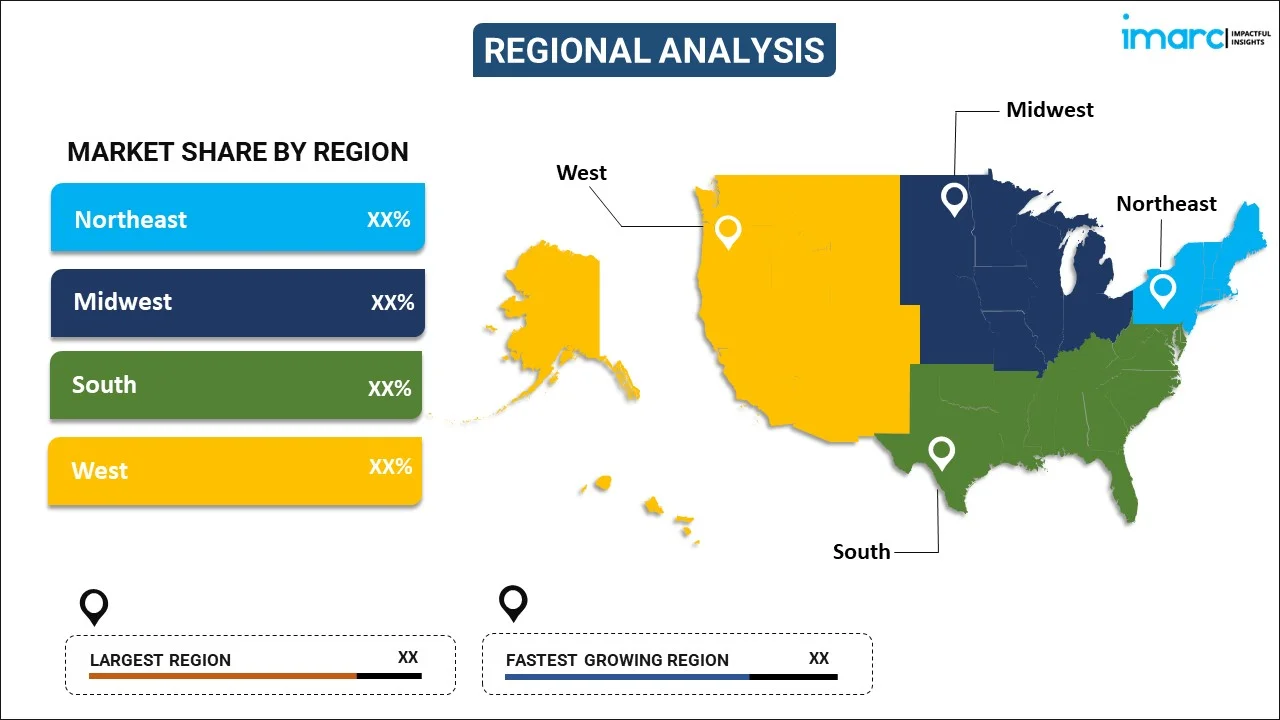
United States Swine Feed Market Report by Product Type (Grower, Starter, Sow, and Others), Feed Essence (Vitamins, Antioxidants, Feed Acidifiers, Feed Enzymes, Amino Acids, and Others), Feed Additive Type (Zootechnical Feed Additives, Sensory Feed Additives, Nutritional Feed Additives), and Region 2025-2033
Market Overview:
The United States swine feed market size reached USD 25,737.7 Million in 2024. Looking forward, IMARC Group expects the market to reach USD 38,668.8 Million by 2033, exhibiting a growth rate (CAGR) of 4.4% during 2025-2033.
|
Report Attribute
|
Key Statistics
|
|---|---|
|
Base Year
|
2024
|
|
Forecast Years
|
2025-2033
|
|
Historical Years
|
2019-2024
|
|
Market Size in 2024
|
USD 25,737.7 Million |
|
Market Forecast in 2033
|
USD 38,668.8 Million |
| Market Growth Rate (2025-2033) | 4.4% |
Swine feed refers to the dietary supplement for pigs, which is made of natural corn, soybean, and wheat ingredients. It is fortified with amino acids, essential fatty acids, vitamins, and minerals to meet the nutritional requirement of pigs. A wide variety of pellets and mash swine feeds are available in the market, which helps in improving the performance goals and herd health as they comprise proteins made of all-natural plant sources and natural fungal-based enzymes.
The United States swine feed market is primarily driven by the rising demand for pork, as it is cheaper, highly nutritious, and contains less fat and cholesterol compared to beef and other meat products. Additionally, changing regulations and policies in the country, coupled with the growing demand for animal protein, is providing a positive impact on the market growth. Moreover, extensive research and development (R&D) activities regarding the testing of new ingredients and feed formula to produce innovative and efficient swine feed variants are also bolstering the market growth.
Key Market Segmentation:
IMARC Group provides an analysis of the key trends in each sub-segment of the United States swine feed market report, along with forecasts at the country and regional level from 2025-2033. Our report has categorized the market based on product type, feed essence, and feed additive type.
Breakup by Product Type:

- Grower
- Starter
- Sow
- Others
Breakup by Feed Essence:
- Vitamins
- Antioxidants
- Feed Acidifiers
- Feed Enzymes
- Amino Acids
- Others
Breakup by Feed Additive Type:
- Zootechnical Feed Additives
- Sensory Feed Additives
- Nutritional Feed Additives
Breakup by Region:

- Northeast
- Midwest
- South
- West
Competitive Landscape:
The competitive landscape of the industry has also been examined along with the profiles of the key players.
Report Coverage:
| Report Features | Details |
|---|---|
| Base Year of the Analysis | 2024 |
| Historical Period | 2019-2024 |
| Forecast Period | 2025-2033 |
| Units | Million USD |
| Segment Coverage | Product Type, Feed Essence, Feed Additive Type, Region |
| Region Covered | Northeast, Midwest, South, West |
| Customization Scope | 10% Free Customization |
| Post-Sale Analyst Support | 10-12 Weeks |
| Delivery Format | PDF and Excel through Email (We can also provide the editable version of the report in PPT/Word format on special request) |
Key Questions Answered in This Report
The United States swine feed market was valued at USD 25,737.7 Million in 2024.
We expect the United States swine feed market to exhibit a CAGR of 4.4% during 2025-2033.
The sudden outbreak of the COVID-19 pandemic had led to the implementation of stringent lockdown regulations across the nation, resulting in the temporary restriction on production and supply of livestock, feed, and feed ingredients, thereby negatively impacting the United States market for swine feed.
The increasing demand for organic pig meat, along with the introduction of new animal rearing practices and maintenance of high farming standards, is primarily driving the United States swine feed market.
Based on the product type, the United States swine feed market can be categorized into grower, starter, sow, and others. Currently, grower accounts for the majority of the total market share.
Based on the feed essence, the United States swine feed market has been segregated into vitamins, antioxidants, feed acidifiers, feed enzymes, amino acids, and others. Among these, amino acids currently hold the largest market share.
Based on the feed additive type, the United States swine feed market can be bifurcated into zootechnical feed additives, sensory feed additives, and nutritional feed additives. Currently, nutritional feed additives exhibit a clear dominance in the market.
On a regional level, the market has been classified into Northeast, Midwest, South, and West, where West currently dominates the United States swine feed market.
Need more help?
- Speak to our experienced analysts for insights on the current market scenarios.
- Include additional segments and countries to customize the report as per your requirement.
- Gain an unparalleled competitive advantage in your domain by understanding how to utilize the report and positively impacting your operations and revenue.
- For further assistance, please connect with our analysts.
 Inquire Before Buying
Inquire Before Buying
 Speak to an Analyst
Speak to an Analyst
 Request Brochure
Request Brochure
 Request Customization
Request Customization




.webp)




.webp)












